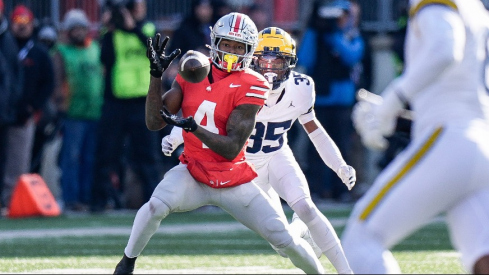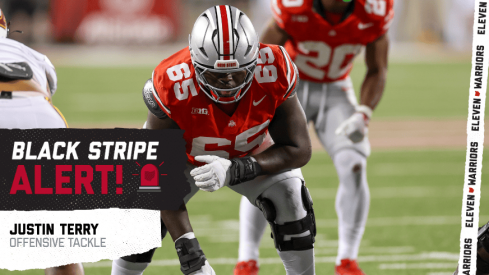
With Ohio State's 2012 season in the books, it is time to look back at the Buckeyes' development and what it may portend for 2013. I will first examine how OSU's offensive and defensive schemes evolved, followed by a more in-depth look at the Buckeyes' personnel. Up first is the Ohio State defense.
A Study in Evolution
It would be difficult to find a more tangible improvement over the course of the season than the Ohio State defense, both in scheme and execution. While much of the preseason focus was upon Urban Meyer installing his spread-to-run scheme, the Ohio State defensive coaching staff was also undergoing a transition. Other than Luke Fickell and Mike Vrabel, the defensive coaches had not worked together before.
While they came from similar schematic backgrounds, there were still differences in terms of how and when to apply certain looks. In addition, the OSU defense did make one sizeable change—the Buckeyes went from being primarily a cover-3 defense to one that operates from cover 4.
This meant differences in how the back seven provided force, alley and leverage support—the critical aspects of any defense.

Meyer, while not actively involved with the defense, certainly had ideas as to how he wanted the defense to operate. And Fickell had never handled play-calling duties. Put that together and it's not entirely surprising that the Buckeyes would have growing pains.
Big Play Blues
Putting the secondary adjustments aside, the Buckeye defense operated from the same basic fronts they have used over the last decade. Against '21' personnel (2 RB, 1 TE) OSU primarily played a 4-3 under defense.


Then, against '10' or '11' personnel, OSU flipped to its 4-2-5 over defensive front.


Then, on third and long, OSU would at times employ a 30 odd front with the weakside end or 'Viper' roaming.

This framework largely stayed in place throughout the season. What did evolve was how the Buckeye front and secondary were deployed post-snap.
Cause and Effect
The Buckeye defense faced a confluence of factors early in the season that led to suboptimal performances. These issues were self-reinforcing, making it difficult to identify how to fix the core problem. They included:
- No personnel to fill the crucial positions of Mike linebacker and the hybrid 'star' defender, who could defend the wide flat against spread offenses.
- Early season injuries to CJ Barnett, which further depleted the safety and star position.
- Conflicting pressures on the coaching staff who wanted to play cover 4 against such spread defenses but did not necessarily have the personnel at these positions to play the man coverage that this defense often requires.
- A corresponding problem with force support from cover 4, given the up-the-middle holes in the back seven.
The above resulted in the the defensive coaching staff failing to commit to a schematic framework. Specifically, OSU shuffled back and forth between basing from cover 4 and the cover 3 that OSU's players were more familiar with. This resulted in shuffling through different ideas and inconsistent responses to how an offense was attacking the defense. It also may have resulted in a seeming hesitancy by the players due to the yo-yo effect.
From there, as one might expect, offenses schemed to attack the weaknesses identified above. Specifically, offenses used two recurring ideas:
- Put their tight end to the boundary and twins or trips to the field. This negated OSU's best corner, Bradley Roby, who lined up to the boundary and would not get a receiver to his side. It then correspondingly forced OSU's weaker safeties, star and linebackers into coverage.
- Employ a quick passing game attacking the underneath flats. This negated the strength of the Buckeye defense—its defensive line—and again exploited these field force players.
Stuck Between a Tock and a Hard Place
Whether because of one or all of the above factors, OSU's early season defense faced one primary problem—giving up 'explosive' plays, i.e. those over 20 yards. This was not simply a scheme problem, but was also a result of poor execution. For example, in multiple instances OSU rushed three and played a coverage-first cover 3, 5 under. Yet OSU's secondary had fundamental breakdowns in scheme, leading to big plays.
But on the opposite end of the spectrum, OSU's cover 4 did expose certain Buckeye defenders in man coverage.
These breakdowns also extended to defending the outside run game. Again, the Buckeyes struggled with setting the edge, lacking consistent force contain and then linebackers properly filling inside-out.
Lesser of Two Evils?
To try to prevent these issues, the OSU coaching staff would revert to a soft base cover 4. This may have been insurance against explosive plays, but it allowed offenses to dink and dunk in the underneath flats. While cover 4 can adjust to a defense attempting to do so, such as making a 'Meg' call that puts the corner in tighter man coverage, OSU remained in a soft shell to protect against getting beat deep. This perhaps reached its logical absurdity against Indiana, where the Hoosiers were able to literally run the same play ad infinum, a double slant package with a halfback flat route.
These two related problems of allowing big plays or getting gashed underneath largely overshadowed what were at times solid defensive performances. This was most exemplified against Michigan State, where OSU was able to play the Spartans' inside run game with strength versus strength. OSU defensive front was always a strength, so offenses worked to avoid attacking between the tackles.
But even in games such as Indiana, which will never be remembered as a positive performance, the Buckeyes forced six consecutive three and outs, only to be overshadowed by a late bombardment of fourth quarter points when the game was in hand. This perhaps foreshadowed that the Ohio State defense had room for growth if they could simply put a stop on allowing big plays.
We Could Go One of Two Ways...
But to their credit, the OSU coaching staff and players continued to work to improve. Following Indiana, the Buckeye defense set itself on an upward trajectory through the remainder of the season, culminating in the Buckeye defense bailing out the Ohio State offense and special teams at times against Penn State, Wisconsin, and Michigan. Again, the personnel and scheme issues cannot be entirely disentangled.
The personnel changes cannot be understated. The most obvious, of course, was the insertion of Zach Boren at Mike linebacker. Boren was not perfect, but he played downhill with good leverage against the run game, taking on blockers in the hole, not to mention the toughness and leadership he brought to this side of the football. Boren's play in turn contributed to perhaps the other most important factor, which was the vastly improved play of Ryan Shazier.
As exemplified by the Cal play above, Shazier was always athletic but often out-of-control, overrunning plays and using poor fundamentals. This dramatically changed by Big Ten season. Shazier began playing with great leverage, playing inside-out and downhill. The combination of essentially two different players vastly altered the Buckeyes' early season weakness in its linebacker play.
The improving health of Barnett and Nathan Williams also led to better team defensive play, particularly on the edge, lessening some of the most acute force problems OSU faced in the early part of the season.
It Takes Two to Tango
Yet it is also undoubtedly the case that OSU's personnel was benefited by improved scheme cohesion. Most importantly, the defensive coaching staff settled on a basic framework. This cohesive framework had multiple benefits. It gave the coaching staff readily available answers to situations throughout games, rather than a grab-bag approach. It also allowed the defense to continually rep repeatable plans. This framework consisted of the following:
On run downs:
- 2-high based cover 4 or quarter-quarter-half coverage against 'spread' offenses (10 or 11 personnel).
- 1-high based safety approach, primarily cover 1 against under center pro-style formations.
On pass downs, the Buckeyes then sought to keep defenses off-balance:
- mixing and matching man and zone blitzes
- With more traditional cover 3 and cover 2 schemes. The use of cover 2 in particular seemed to ameliorate some of the breakdowns that the Buckeyes were having on third and long.
Almost There
In addition, the defensive coaches began making some subtle adjustments to confront repeated issues that plagued the defense earlier in the season. While in the early season the defensive staff had difficulty adapting to looks from opposing offenses, as the season progressed they began to get their 'sea legs' and make adjustments that responded to how offenses were approaching the Buckeye defense.
The primary adaptation was making schematic changes to shore up the contain issues that caused OSU so many early season problems. For instance, the Buckeyes responded to the aforementioned offensive approach of placing their receivers to the field and tight end to the boundary with quarter-quarter-half coverage. This allowed Bradley Roby to provide force support, largely eliminating the lack of boundary contain that plagued Ohio State earlier in the season. Roby is extremely physical as a corner, allowing him to handle this duty if teams formationed to put their receivers away from him.

To the field, the Buckeye coaching staff addressed their force issues by altering how the defense provided force support from cover 4. The Buckeyes altered the star and safety's role, with the nickel back providing contain, and the safety filling as the alley player. Again, the defensive coaching staff was searching for a method to provide consistent outside leverage.
One other largely imperceptible change is that the Buckeyes gave Zach Boren an automatic blitz read based upon whether his offensive backfield counterpart stayed in and blocked.
This was generally reflective of the fact that the Buckeyes became more aggressive in pass downs as the season progressed. OSU increasingly relied upon pressure to force quarterbacks into quick decisions. Perhaps not coincidentally, the Buckeye defense was better at getting off the field on third down, another problem that had plagued OSU earlier in the season.
Thus, though the OSU defensive scheme did not undergo drastic scheme changes, they came to a uniformity to their overall framework and made subtle shifts that addressed the contain, pressure, and big play issues that handicapped the defense earlier in the season. While the Buckeye defense was never necessarily dominant, it nonetheless minimized its earlier mistakes to the point where Meyer and the Buckeyes could rely upon the defense to make plays and win games.

